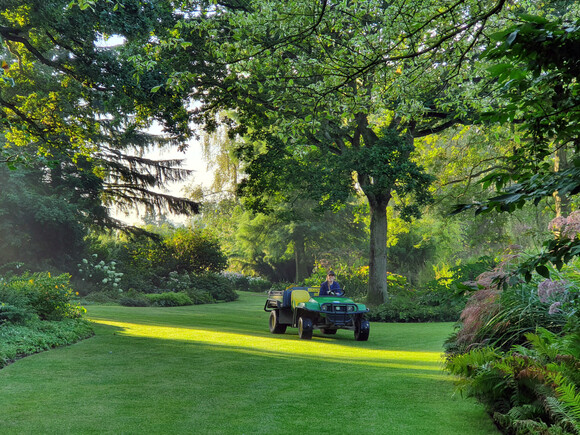Find out what the propagation and garden teams have been up to this week.

Autumn jobs in the garden

Autumn lawn care
Ben and Ned from the grounds team have been working hard to keep the grass looking tip-top for our visitors. Firstly the whole area was scarified, removing the thatch that has built up over the year.

The whole area was then hollow-tined, making holes in the ground to relieve compaction and aerate the soil.


The next step was to add a bespoke mix of sand and soil to the ground which was then brushed into the holes. Finally, the whole area was watered to ensure everything settled. As the grassed areas receive a lot of footfall throughout the year, it is important to carry out this process to keep the lawn looking its best.


Succulents and half-hardy pot displays
As we head further into autumn and the weather begins to turn, Beth’s succulent and half-hardy collections are moved from their outside, summer positions into the frost-free greenhouse to overwinter. These potted treasures will remain here until the threat of frost has passed- usually around mid-May.
Read on: Summer Pot Displays



An extract from The Green Taspestry Revisited:
‘While the garden has always been planted up on a permanent basis, using mostly hardy perennials and some shrubs but little in the way of successional planting, the use of half-hardy plants has still been a constant feature. Each year, usually in late May or early June, a special ‘pot’ compost is made and the pots planted up. The pot displays are mainly concentrated around the house and the adjacent tearoom/garden entrance area. These include Beth’s ever-present collection of succulents, which are moved out from the greenhouse during the frost-free months and displayed invitingly en masse. This collection has been increased over the years and has always sat well with our dry East Anglian summers.’

Pond maintenance
In an attempt to try and clear duck weed from the ponds, the garden team have been flushing them through. This is done by inserting a bung in the pipe between each pond, stopping the flow of water. When the water builds up, the bung is removed, forcing water and hopefully duckweed into the next pond. Starting with the first pond, the process is continued until the water is flushed through to the canal bed at the end of the Water Garden, eventually washing into the neighbouring reservoir. This certainly won’t get rid of the duck weed completely but will help to reduce the amount in each pond.


For a weekly catch up with the garden team, follow our social channels:



Oh I wish I had discovered you sooner.
What a good source of information regarding plant choices. Your grounds look amazing. Thank you for sharing
Chris
Thankyou Teresa